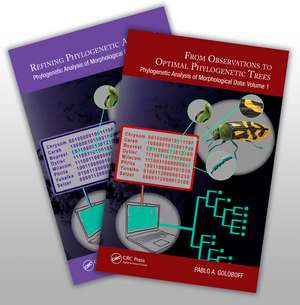Phylogenetic Analysis of Morphological Data: Two Volume Set
Autor Pablo A. Goloboffen Limba Engleză Paperback – 26 aug 2024
Key Features
- Provides in depth discussion of the connections between hypotheses of homology and the parsimony criterion
- Helps understand the basis for designing different aspects of a morphological study, from hints on delimiting the problem and data collecting, to character definitions and analysis
- Discusses the applicability of statistical models coopted from sequence analysis to the analysis of morphological data
- Gives detailed descriptions of the principles behind algorithms for evaluating and searching phylogenetic trees
- Presents extensive information on commands and options of the TNT computer program
Preț: 695.48 lei
Preț vechi: 764.26 lei
-9% Nou
Puncte Express: 1043
Preț estimativ în valută:
133.10€ • 144.52$ • 111.80£
133.10€ • 144.52$ • 111.80£
Carte tipărită la comandă
Livrare economică 22 aprilie-06 mai
Preluare comenzi: 021 569.72.76
Specificații
ISBN-13: 9781032287737
ISBN-10: 103228773X
Pagini: 664
Ilustrații: 130
Dimensiuni: 156 x 234 mm
Greutate: 1.23 kg
Ediția:1
Editura: CRC Press
Colecția CRC Press
Locul publicării:Boca Raton, United States
ISBN-10: 103228773X
Pagini: 664
Ilustrații: 130
Dimensiuni: 156 x 234 mm
Greutate: 1.23 kg
Ediția:1
Editura: CRC Press
Colecția CRC Press
Locul publicării:Boca Raton, United States
Public țintă
AcademicCuprins
Volume I. Chapter 1. Introduction to Phylogenetics. Chapter 2. Characters, Homology, and Datasets. Chapter 3. Character Optimization: Evaluation of Trees and Inference of Ancestral Values. Chapter 4. Models and Assumptions in Morphology. Chapter 5. Choice of phylogenetic hypothesis: Tree searches.
Volume II. Chapter 6. Summarizing and Comparing Phylogenetic Trees. Chapter 7. Character weighting. Chapter 8. Measuring degree of group support. Chapter 9. Morphometric characters. Chapter 10. Scripting: the next level of TNT mastery.
Volume II. Chapter 6. Summarizing and Comparing Phylogenetic Trees. Chapter 7. Character weighting. Chapter 8. Measuring degree of group support. Chapter 9. Morphometric characters. Chapter 10. Scripting: the next level of TNT mastery.
Notă biografică
Born in Buenos Aires, Pablo A. Goloboff became interested in spider biology and systematics in the late 70’s, in the Museo Argentino de Ciencias Naturales. His first papers (published during the 80’s) were on spider systematics, but he soon became more interested in systematic theory and phylogenetic methods. He graduated with a Licenciatura in Biology in 1989, from Universidad de Buenos Aires, and then pursued doctoral studies in Cornell University and the American Museum of Natural History, in New York, between 1989 and 1994. He published his first methodological papers in the early 90’s, gradually switching his research from spider systematics to systematic theory. During his stay at Cornell University, he became more involved with quantitative methods for parsimony analysis, and wrote his first computer programs. He moved to Tucumán in 1994, to work for the CONICET, and continued working on theory and methods for systematics and historical biogeography. He has published over a hundred scientific papers and about a dozen computer programs, the best known of which are Nona, Piwe, TNT (for phylogenetics), and VNDM (for biogeography). He is a Fellow Honoris Causa of the Willi Hennig Society, and served as President of the society from 2004 to 2006. Since 1995, he has been regularly teaching courses on phylogenetics in Argentina and about a dozen countries.
Recenzii
“There is no question that Goloboff provides a rigorous, logical and analytically sound framework for analyzing data – probably the most carefully considered rationale that has ever been published for phylogenetics of any kind of data … “
- Andrew Brower, Assistant Director at USDA Animal and Plant Health Inspection Service (APHIS)
“… this book is focused on phylogenetic analyses based on morphological date [and] paleontologists will find its content particularly useful. … provide[s] both researchers and students alike with the theoretical bases and tools for the correct building of robust phylogenetic data matrices, their analysis, and subsequent interpretation. [this book] will become a ‘must-read’ …”
- M. D.Ezcurra in Ameghiniana, 2024, vol 61 (1).
- Andrew Brower, Assistant Director at USDA Animal and Plant Health Inspection Service (APHIS)
“… this book is focused on phylogenetic analyses based on morphological date [and] paleontologists will find its content particularly useful. … provide[s] both researchers and students alike with the theoretical bases and tools for the correct building of robust phylogenetic data matrices, their analysis, and subsequent interpretation. [this book] will become a ‘must-read’ …”
- M. D.Ezcurra in Ameghiniana, 2024, vol 61 (1).
Descriere
This two-volume book is a revision of methods and principles of phylogenetic analysis of morphological data. It is also a general guide for using the computer program TNT in the analysis of such data. The book covers the main aspects of phylogenetic analysis, and general methods to compare classifications derived from molecules and morphology.
